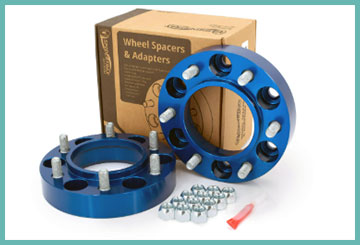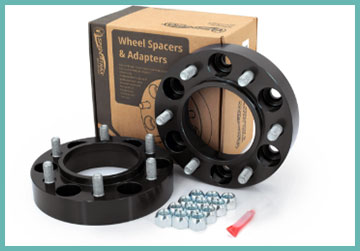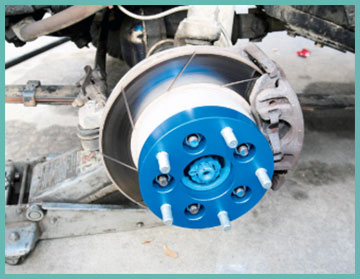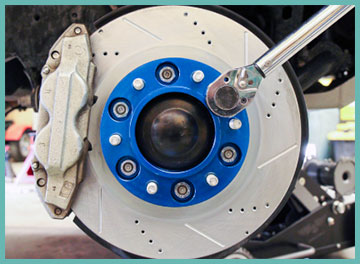I’m not one to throw money at every shiny car mod, but Spidertrax wheel spacers have earned their spot in my garage and on my truck.
These spacers transformed my Toyota Tacoma’s stance, giving it that aggressive, planted look I was chasing without breaking the bank on new wheels.
They’re built tough, hub-centric, and made to last, which is why I’m sold on them for anyone looking to level up their ride’s performance and style.
In this article, I’ll share my journey with Spidertrax, break down the good and the bad, offer maintenance tips, and stack them up against other brands. Trust me, you’ll want these on your vehicle.
My Experience With Spidertrax Wheel Spacers
I’ve always loved the look of a wide stance on a truck, but when I got my 2018 Toyota Tacoma, the stock wheels felt a bit tucked in, like it was shy about taking up space. After some research and a few too many late-night forum dives, I landed on Spidertrax 1.25-inch wheel spacers.
I figured they’d give me the look I wanted without the cost of new rims, and boy, was I right. Installing them was my first hurdle, but it wasn’t as daunting as I’d feared. The kit came with everything I needed: pre-installed 4140 chromoly wheel studs, lug nuts, and even a packet of red Loctite for good measure.

The installation took me about an hour in my driveway with a torque wrench and a buddy to hold the brakes. I followed Spidertrax’s instructions to the letter, torquing the spacers to 90 ft/lbs and checking them after a 50-mile drive.
The process felt straightforward, almost like bolting on a new wheel, but I was nervous about vibrations or wobble. To my relief, the hub-centric design kept everything perfectly aligned. No shakes, no rattles—just a smooth ride.
On the road, the difference was immediate. My Tacoma felt more planted, especially on sharp corners at 45 mph, where the wider track added stability.
Off-road, I took it through some rocky trails in Colorado, and the spacers gave my 33-inch tires just enough clearance to avoid rubbing the upper control arms at full lock. I’ve put about 15,000 miles on them now, with a mix of highway cruising and off-road adventures, and they’ve held up like champs. The blue anodized finish still pops, and I haven’t noticed any corrosion, even after muddy runs.
The only hiccup? I had to double-check the torque after a particularly rough trail, but that’s more about my paranoia than any real issue. Spidertrax spacers have made my truck look and feel like a beast, and I’m hooked.
Read More: My Thoughts On Suds Lab Wheel Cleaner
Pros Of Spidertrax Wheel Spacers
- Enhanced Stability and Handling: The wider stance from these 1.25-inch spacers made my Tacoma feel like it was glued to the road. Whether I’m navigating windy highways or tackling off-road trails, the added track width reduces body roll and improves cornering. It’s like giving your vehicle a confidence boost.
- Perfect Fit with Hub-Centric Design: Spidertrax spacers are hub-centric, meaning they align perfectly with your wheel hub, not just the lug nuts. This eliminates vibrations and ensures a smooth ride. I felt zero wobble, even at 70 mph, which isn’t something you can say about cheaper spacers.
- High-Quality Materials: Made from 6061T6 aluminum and anodized to fight corrosion, these spacers are built to last. After a year of mud, snow, and road salt, mine still look nearly brand new. The pre-installed 4140 chromoly studs are beefy and inspire confidence.
- Easy Installation: The bolt-on design is a DIYer’s dream. With a torque wrench and basic tools, I had them installed in under an hour. The included lug nuts and thread locker mean you’re not scrambling for extra parts.
- Aesthetic Upgrade: Let’s be real—you want your ride to look good. These spacers push your wheels out just enough to give that aggressive, flush look without sticking out past the fenders. My Tacoma went from “meh” to “mean” with minimal effort.
- Versatility Across Vehicles: Spidertrax makes spacers for a range of vehicles, from Toyotas to Jeeps and Fords. Whether you’re driving a 4Runner or a Wrangler, there’s a kit that fits. I’ve even seen friends use them on their Tundras with great results.
- No Major Impact on Fuel Economy: I was worried spacers might tank my gas mileage, but the impact was negligible. Sure, the wider stance adds a tiny bit of drag, but I didn’t notice any significant dip at the pump.
Cons Of Spidertrax Wheel Spacers

- Increased Stress on Wheel Bearings: Spacers push the wheels out, which can add leverage and stress to your wheel bearings and CV shafts. I haven’t had issues yet, but if you’re doing hardcore off-roading, you’ll need to keep an eye on these components and expect more frequent maintenance.
- Pricey Compared to Budget Options: Spidertrax spacers aren’t cheap. I paid around $150 for a pair, and you’ll need two pairs for all four wheels. Compare that to some Amazon specials at $50 a pair, and it stings. But you get what you pay for—quality isn’t free.
- Potential for Rubbing with Larger Tires: If you’re running oversized tires with a lift kit, spacers might cause rubbing on the firewall or body mounts. I had to double-check my 33-inch tires to ensure clearance, especially at full lock. Research your setup thoroughly.
- Maintenance Requirements: These aren’t a “set it and forget it” mod. You’ll need to check torque periodically, especially after off-road trips. I found myself crawling under the truck every few months to make sure everything was tight, which can be a hassle.
- Color Limited to Blue: The bright blue finish is cool, but it’s the only option. If you’re picky about aesthetics, you might wish for black or silver to blend in better. It’s a minor gripe, but I’d love more choices.
- Not Ideal for Extreme Widths: Spidertrax sticks to safer widths like 1.25 or 1.5 inches. If you’re looking for a 3-inch spacer for a super-wide stance, you’re out of luck. They prioritize safety over extreme customization, which isn’t a bad thing but limits options.
Maintenance Tips For Spidertrax Wheel Spacers

- Check Torque Regularly: After installing your spacers, torque them to Spidertrax’s recommended 90 ft/lbs and recheck after 50 miles. I make it a habit to check every 3,000 miles or after a rough off-road session. A loose spacer can cause vibrations or worse, so don’t skip this step.
- Use Thread Locker Properly: The included red Loctite is a must for securing the spacers to the hub. Apply it to clean threads, and if you ever remove the spacers for maintenance, clean and reapply. I learned the hard way that skipping this can lead to loose bolts—don’t be me.
- Inspect for Corrosion: The anodized aluminum holds up well, but road salt and mud can still take a toll. After every off-road trip, I rinse my spacers with a hose and check for any pitting. A quick scrub with a soft brush keeps them looking sharp.
- Monitor Wheel Bearings: Spacers can stress your bearings, so listen for humming or grinding noises. I check my bearings every oil change, about every 5,000 miles, to catch any wear early. If you’re a heavy off-roader, consider more frequent checks.
- Clean Threads Before Installation: Before bolting on your spacers, clean the wheel studs and hub thoroughly. Dirt or rust can mess with the fitment and cause alignment issues. I used a wire brush to ensure a clean surface, and it made installation a breeze.
- Rotate Tires Evenly: Spacers change the load on your tires, so make sure your tire rotation schedule is consistent. I stick to a 5,000-mile rotation to keep wear even and extend tire life, especially with the added stress of a wider stance.
- Avoid Over-Torquing: It’s tempting to crank down on those lug nuts, but over-torquing can damage the studs or spacers. Stick to the recommended 90 ft/lbs. I use a torque wrench every time to avoid any mishaps.
Comparison With Other Brands

Bora Wheel Spacers
Bora spacers, made by Motorsport-Tech, are often mentioned in the same breath as Spidertrax, and for good reason. They’re also made from high-quality 6061T6 aluminum and are hub-centric, offering a precise fit. I’ve spoken to a friend who runs 1.5-inch Bora spacers on his Land Cruiser, and he swears by their durability after 60,000 miles of mixed on- and off-road driving. Bora’s edge is their custom machining options, like milling for specific hub flanges, which Spidertrax doesn’t offer. However, Bora spacers are pricier, often costing $200 or more per pair, and their customer service isn’t as responsive as Spidertrax’s. I chose Spidertrax for the lower price and included hardware, but Bora is a solid alternative if you need custom specs.
KSP Wheel Spacers
KSP spacers are a budget-friendly option, often found on Amazon for around $80 per set of four. They’re hub-centric and made from aluminum, but the quality feels a step below Spidertrax. A buddy of mine tried KSP on his Jeep Wrangler and noticed slight vibrations at high speeds, which he didn’t get with Spidertrax. KSP’s black finish is less flashy than Spidertrax’s blue, which some prefer, but the studs are only grade 10.9, not as robust as Spidertrax’s 4140 chromoly. For light use, KSP might do the job, but I wouldn’t trust them for heavy off-roading like I do with Spidertrax.
Rough Country Wheel Spacers
Rough Country spacers are another affordable option, typically priced around $60 per pair. They’re popular for their low cost and availability, but the quality is hit-or-miss. I read horror stories on forums about Rough Country spacers with weak studs that snapped during hard off-roading—something I’ve never heard about Spidertrax. They’re not always hub-centric, which can lead to balance issues. I considered Rough Country to save money but decided the risk wasn’t worth it. Spidertrax’s over-engineered design and reputation for reliability make it the safer bet for serious drivers.
Supreme Suspensions Wheel Spacers
Supreme Suspensions offers hub-centric spacers at a mid-range price point, around $100 for a set of four. They’re made from durable aluminum and come with a lifetime warranty, which is a nice touch. A forum user I follow reported easy installation and no vibrations, but the spacers required trimming the factory studs for a proper fit, which Spidertrax didn’t. Supreme’s black finish blends better with most wheels, but their studs aren’t as strong as Spidertrax’s, and the brand lacks the off-road pedigree. I stuck with Spidertrax for its proven track record in rugged conditions.
G2 Axle & Gear Wheel Spacers
G2 spacers are designed for heavy-duty use, particularly on Jeeps, and cost about $120 per pair. They’re hub-centric and made from high-grade aluminum, with a focus on off-road durability. A Jeep-owning friend used G2 1.75-inch spacers to clear 37-inch tires and had no issues after a year of rocky trails. However, G2 spacers often require longer lug nuts, which aren’t always included, unlike Spidertrax’s complete kit. I prefer Spidertrax for its all-in-one package and slightly lower price, but G2 is a strong contender for Jeep enthusiasts needing wider spacers.
Read More: My Thoughts On Meguiar’s Ultimate All Wheel Cleaner
Frequently Asked Questions (FAQ)
Spidertrax spacers are top-notch. They’re made from 6061T6 aluminum, hub-centric for perfect alignment, and built to handle tough off-road conditions. I’ve run them on my Tacoma for 15,000 miles with no issues—smooth on highways and reliable on trails. Their reputation in the off-road community is stellar, with users reporting 60,000+ miles of trouble-free use when properly installed. The included high-grade studs and thread locker add to their reliability. Just make sure you torque them correctly and check periodically.
Wheel spacers have some drawbacks. They can increase stress on wheel bearings and CV shafts due to the wider track, potentially leading to faster wear, especially during heavy off-roading. I haven’t had issues, but I monitor my bearings closely. Spacers can also cause tire rubbing with certain lift kits or oversized tires, so you need to research your setup. Maintenance is another factor—regular torque checks are a must. Cheap spacers might cause vibrations or failures, but high-quality ones like Spidertrax minimize these risks.
Spidertrax and Bora lead the pack for quality and reliability. Spidertrax is my go-to for its complete kit, hub-centric design, and off-road pedigree. Bora offers custom machining but at a higher price. Synergy is another solid choice for Jeep owners, with strong studs and easy installation. Budget brands like KSP and Rough Country are cheaper but riskier, with reports of weak studs or vibrations. Supreme Suspensions offers a decent mid-range option with a warranty, but Spidertrax’s balance of quality and value is hard to beat.
Wheel spacers don’t inherently destroy bearings, but they can accelerate wear by increasing leverage on the wheel hub. I’ve had no bearing issues after 15,000 miles with Spidertrax spacers, but I’m careful not to shock-load my drivetrain during off-roading. Proper installation—using hub-centric spacers, correct torque, and thread locker—helps minimize stress. Regular maintenance, like checking bearings every 5,000 miles, is key. Cheap spacers or improper installation can cause problems, but high-quality spacers like Spidertrax are safe when maintained properly.
Conclusion: For Spidertrax Wheel Spacers
If you want a wider stance, better handling, and a killer look for your truck or Jeep, Spidertrax wheel spacers are a no-brainer. They’re pricier than budget options, but the quality, durability, and ease of installation make them worth every penny. I’ve trusted them on my Tacoma for thousands of miles, and they’ve never let me down. With proper maintenance, they’re as reliable as they come. Go grab a set from spidertrax.com and give your ride the upgrade it deserves—you won’t regret it.
Meta Description: Discover why Spidertrax wheel spacers are a game-changer for your vehicle. My in-depth review covers pros, cons, maintenance tips, and comparisons with other brands, all from real-world experience. Learn how these spacers boost style and performance.
